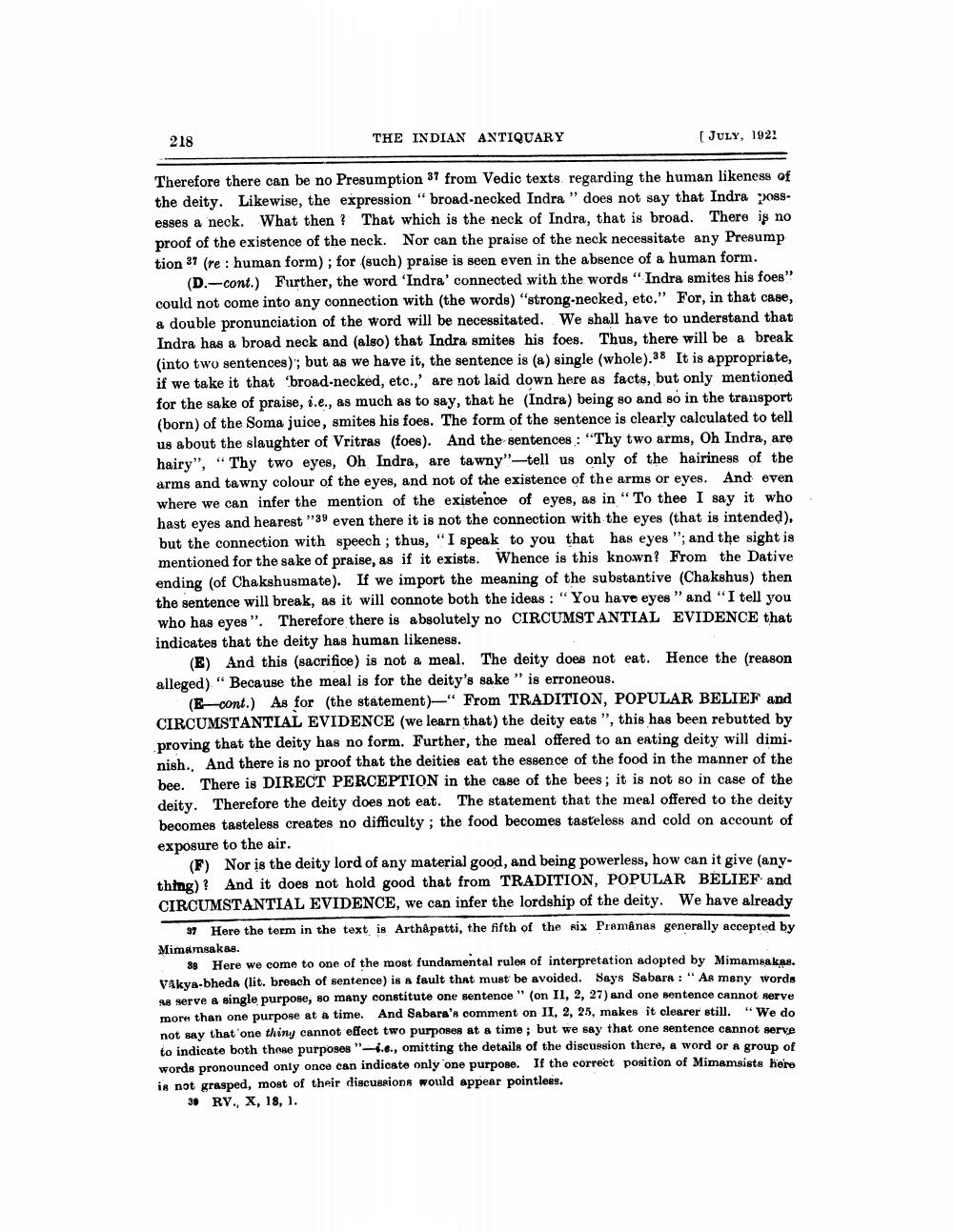________________
218
THE INDIAN ANTIQUARY
(JULY, 192:
Therefore there can be no Presumption 37 from Vedic texts regarding the human likeness of the deity. Likewise, the expression “broad-necked Indra" does not say that Indra possesses a neck. What then? That which is the neck of Indra, that is broad. There is no proof of the existence of the neck. Nor can the praise of the neck necessitate any Presump tion 37 (re: human form); for (such) praise is seen even in the absence of a human form.
(D.--cont.) Further, the word 'Indra' connected with the words "Indra smites his foes" could not come into any connection with the words) "strong-necked, etc." For, in that case, a double pronunciation of the word will be necessitated. We shall have to understand that Indra has a broad neck and (also) that Indra smites his foes. Thus, there will be a break (into two sentences); but as we have it, the sentence is (a) single (whole). 38 It is appropriate, if we take it that broad-necked, etc.,' are not laid down here as facts, but only mentioned for the sake of praise, i.e., as much as to say, that he (Indra) being so and so in the transport (born) of the Soma juice, smites his foes. The form of the sentence is clearly calculated to tell us about the slaughter of Vritras (foes). And the sentences : "Thy two arms, Oh Indra, are hairy", "Thy two eyes, Oh Indra, are tawny"-tell us only of the hairiness of the arms and tawny colour of the eyes, and not of the existence of the arms or eyes. And even where we can infer the mention of the existence of eyes, as in "To thee I say it who hast eyes and hearest "39 even there it is not the connection with the eyes (that is intended), but the connection with speech; thus, "I speak to you that has eyes"; and the sight is mentioned for the sake of praise, as if it exists. Whence is this known? From the Dative ending (of Chakshusmate). If we import the meaning of the substantive (Chakshus) then the sentence will break, as it will connote both the ideas : "You have eyes " and "I tell you who has eyes". Therefore there is absolutely no CIRCUMSTANTIAL EVIDENCE that indicates that the deity has human likeness.
(E) And this (sacrifice) is not a meal. The deity does not eat. Hence the reason alleged). "Because the meal is for the deity's sake " is erroneous.
(E-cont.) As for the statement)" From TRADITION, POPULAR BELIEF and CIRCUMSTANTIAL EVIDENCE (we learn that) the deity eats ", this has been rebutted by proving that the deity has no form. Further, the meal offered to an eating deity will dimi. nish., And there is no proof that the deities eat the essence of the food in the manner of the bee. There is DIRECT PERCEPTION in the case of the bees; it is not so in case of the deity. Therefore the deity does not eat. The statement that the meal offered to the deity becomes tasteless creates no difficulty ; the food becomes tasteless and cold on account of exposure to the air.
(F) Nor is the deity lord of any material good, and being powerless, how can it give (any. thing)? And it does not hold good that from TRADITION, POPULAR BELIEF. and CIRCUMSTANTIAL EVIDENCE, we can infer the lordship of the deity. We have already
37 Here the term in the text is Arthâpatti, the fifth of the six Pramânas generally accepted by Mimamsakas.
89 Here we come to one of the most fundamental ruler of interpretation adopted by Mimamsakas. Vakya-bheda (lit. breach of sentence) is a fault that must be avoided. Says Sabara: "As many words so serve a single purpose, so many constitute one sentence" (on II, 2, 27) and one sentence cannot serve more than one purpose at a time. And Sabara's comment on II, 2, 25, makes it clearer still. "We do not say that one thiny cannot effect two purposes at a time, but we say that one sentence cannot serve to indicate both these purposes"-4.6., omitting the details of the discussion there, a word or a group of words pronounced only once can indicate only one purpose. If the correct position of Mimamsists here is not grasped, most of their discussions would appear pointless.
39 RV., X, 18, 1.




